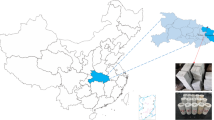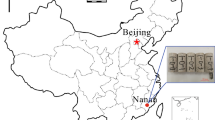Abstract
In this paper, the characteristics of microscopic failure and macroscopic mechanics of gritstone are studied experimentally under geothermal conditions. Different hydrothermal and cooling treatments are conducted to simulate geothermal environments. Permeability and triaxial compression tests of treated gritstone specimens are employed to obtain complete stress–strain curves and permeability and to discuss the mechanical properties of gritstone under various high-temperature, high-pressure, and cooling conditions. The results show that, in the hydrothermal study, the triaxial compressive strength of gritstone increases as the pre-treating pressure. In the cooling study, the specimen cooled in an autoclave had the lowest strength and the largest peak strain, while the air-cooled specimen had the greatest strength. Furthermore, pre-treatment with water at high pressure and temperature had a significant influence on the permeability of specimens. The permeability increased with increasing pre-treatment water pressure. In the cooling study, specimens cooled in an autoclave had the highest permeability. The microscopic characteristics of gritstone were analyzed by scanning electron microscopy (SEM) images. The SEM images showed that internal defects, such as microcracks induced by hydrothermal and cooling treatments, led to differences in macroscopic behavior. X-ray electron diffraction (XRD) data reflected the changes in the composition and content of specific minerals before and after treatment, and these changes were related to hydrothermal coupling. Analysis of the micro and macro characteristics showed that the temperature and pressure in the geothermal environment affected cracking and dissolution in gritstone, stimulating the initiation and propagation of cracks.













Similar content being viewed by others
References
AbuAisha M, Loret B, Eaton D (2016) Enhanced Geothermal Systems (EGS): hydraulic fracturing in a thermo-poroelastic framework. J Petrol Sci Eng 146:1179–1191. https://doi.org/10.1016/j.petrol.2016.07.027
Bi J, Liu PF, Gan F (2020) Effects of the cooling treatment on the dynamic behavior of ordinary concrete exposed to high temperatures. Constr Build Mater 248:118688. https://doi.org/10.1016/j.conbuildmat.2020.118688
Bi J, Zhou XP, Qian QH (2015) The 3D numerical simulation for the propagation process of multiple pre-existing flaws in rock-like materials subjected to biaxial compressive loads. Rock Mech Rock Eng 49:1611–1627. https://doi.org/10.1007/s00603-015-0867-y
Bonte M, Stuyfzand PJ, Breukelen BM (2014) Reactive transport modeling of thermal column experiments to investigate the impacts of aquifer thermal energy storage on groundwater quality. Environ Sci Technol 48:12099–12107. https://doi.org/10.1021/es502477m
Breede K, Dzebisashvili K, Liu X, Falcone G (2013) A systematic review of enhanced (or engineered) geothermal systems: past present and future. Geotherm Energy 1. https://doi.org/10.1186/2195-9706-1-4
Caulk RA, Ghazanfari E, Perdrial JN, Perdrial N (2016) Experimental investigation of fracture aperture and permeability change within Enhanced Geothermal Systems. Geoth 62:12–21. https://doi.org/10.1016/j.geothermics.2016.02.003
Chen Y, Ma GW, Wang HD (2018) The simulation of thermo-hydro-chemical coupled heat extraction process in fractured geothermal reservoir. Appl Therm Eng 143:859–870. https://doi.org/10.1016/j.applthermaleng.2018.08.015
El Sharawy MS, Nabawy BS (2019) Integration of electrofacies and hydraulic flow units to delineate reservoir quality in uncored reservoirs: a case study, Nubia Sandstone Reservoir, Gulf of Suez. Egypt Nat Resour Res 28:1587–1608. https://doi.org/10.1007/s11053-018-9447-7
Fan LF, Gao JW, Du XL, Wu ZJ (2020) Spatial gradient distributions of thermal shock-induced damage to granite. J Rock Mech Geotech 12:917–926. https://doi.org/10.1016/j.jrmge.2020.05.004
Feng G, Kang Y, Meng T, Hu YQ, Li XH (2017) The influence of temperature on mode I fracture toughness and fracture characteristics of sandstone. Rock Mech Rock Eng 50:2007–2019. https://doi.org/10.1007/s00603-017-1226-y
Grant MA (2016) Physical performance indicators for HDR/EGS projects. Geoth 63:2–4. https://doi.org/10.1016/j.geothermics.2015.01.004
Griffioen J, Appelo CAJ (1993) Nature and extent of carbonate precipitation during aquifer thermal energy storage. Appl Geochem 8:161–176. https://doi.org/10.1016/0883-2927(93)90032-c
Griffiths L, Lengline O, Heap MJ, Baud P, Schmittbuhl J (2018) Thermal cracking in Westerly granite monitored using direct wave velocity coda wave interferometry and acoustic emissions. J Geophys Res-Sol Ea 123:2246–2261. https://doi.org/10.1002/2017jb015191
Gruber C, Kutuzov I, Ganor J (2016) The combined effect of temperature and pH on albite dissolution rate under far-from-equilibrium conditions. Geochim Cosmochim Ac 186:154–167. https://doi.org/10.1016/j.gca.2016.04.046
Hahnlein S, Bayer P, Ferguson G, Blum P (2013) Sustainability and policy for the thermal use of shallow geothermal energy. Energ Policy 59:914–925. https://doi.org/10.1016/j.enpol.2013.04.040
Holmslykke HD, Kjoller C, Fabricius IL (2017) Core flooding experiments and reactive transport modeling of seasonal heat storage in the hot deep gassum sandstone formation. Acs Earth Space Chem 1:251–260. https://doi.org/10.1021/acsearthspacechem.7b00031
Hou JC, Cao MC, Liu PK (2018) Development and utilization of geothermal energy in China: current practices and future strategies. Renew Energ 125:401–412. https://doi.org/10.1016/j.renene.2018.02.115
Hussain A, Arif SM, Aslam M (2017) Emerging renewable and sustainable energy technologies: state of the art. Renew Sust Energ Rev 71:12–28. https://doi.org/10.1016/j.rser.2016.12.033
Jin PH, Hu YQ, Shao JX, Zhao GK, Zhu XZ, Li C (2019a) Influence of different thermal cycling treatments on the physical, mechanical and transport properties of granite. Geoth 78:118–128. https://doi.org/10.1016/j.geothermics.2018.12.008
Jin PH, Hu YQ, Shao JX, Zhao GK, Zhu XZ, Li C (2019b) Influence of different thermal cycling treatments on the physical mechanical and transport properties of granite. Geoth 78:118–128. https://doi.org/10.1016/j.geothermics.2018.12.008
Kim T, Jeon S (2019) Experimental study on shear behavior of a rock discontinuity under various thermal, hydraulic and mechanical conditions. Rock Mech Rock Eng 52:2207–2226. https://doi.org/10.1007/s00603-018-1723-7
Kumari WGP et al (2018) Hydraulic fracturing under high temperature and pressure conditions with micro CT applications: Geothermal energy from hot dry rocks. Fuel 230:138–154. https://doi.org/10.1016/j.fuel.2018.05.040
Kumari WGP et al (2017) Mechanical behaviour of Australian Strathbogie granite under in-situ stress and temperature conditions: an application to geothermal energy extraction. Geoth 65:44–59. https://doi.org/10.1016/j.geothermics.2016.07.002
Li C, Hu YQ, Meng T, Zhang CW, Gao R, Jin PH, Hu YF (2020) Mode-I fracture toughness and mechanisms of salt-rock gypsum interlayers under real-time high-temperature conditions. Eng Fract Mech 240. https://doi.org/10.1016/j.engfracmech.2020.107357
Liu P, Liu X, Tian G, Gan F, Bi J (2019) Effect of thermal cycling and hydro-thermal cycling on physical and mechanical properties of sandstone. Energy Sci Eng 8:718–730. https://doi.org/10.1002/ese3.544
Lu SM (2018) A global review of enhanced geothermal system (EGS). Renew Sust Energ Rev 81:2902–2921. https://doi.org/10.1016/j.rser.2017.06.097
Lund JW, Bjelm L, Bloomquist G, Mortensen AK (2008) Characteristics, development and utilization of geothermal resources—a Nordic perspective. Episodes 31:140–147. https://doi.org/10.18814/epiiugs/2008/v31i1/019
Lund JW, Boyd TL (2016) Direct utilization of geothermal energy 2015 worldwide review. Geoth 60:66–93. https://doi.org/10.1016/j.geothermics.2015.11.004
Najari M, Selvadurai APS (2014) Thermo-hydro-mechanical response of granite to temperature changes. Environ Earth Sci 72:189–198. https://doi.org/10.1007/s12665-013-2945-3
Pandey SN, Chaudhuri A, Kelkar S, Sandeep VR, Rajaram H (2014) Investigation of permeability alteration of fractured limestone reservoir due to geothermal heat extraction using three-dimensional thermo-hydro-chemical (THC) model. Geoth 51:46–62. https://doi.org/10.1016/j.geothermics.2013.11.004
Park JW, Park D, Ryu DW, Choi BH, Park ES (2014) Analysis on heat transfer and heat loss characteristics of rock cavern thermal energy storage. Eng Geol 181:142–156. https://doi.org/10.1016/j.enggeo.2014.07.006
Possemiers M, Huysmans M, Batelaan O (2014) Influence of aquifer thermal energy storage on groundwater quality: a review illustrated by seven case studies from Belgium. J Hydrol-Reg Stud 2:20–34. https://doi.org/10.1016/j.ejrh.2014.08.001
Rawal C, Ghassemi A (2014) A reactive thermo-poroelastic analysis of water injection into an enhanced geothermal reservoir. Geoth 50:10–23. https://doi.org/10.1016/j.geothermics.2013.05.007
Rivera Diaz A, Kaya E, Zarrouk SJ (2016) Reinjection in geothermal fields - a worldwide review update. Renew Sust Energ Rev 53:105–162. https://doi.org/10.1016/j.rser.2015.07.151
Schmidt RB, Bucher K, Druppel K, Stober I (2017) Experimental interaction of hydrothermal Na-Cl solution with fracture surfaces of geothermal reservoir sandstone of the Upper Rhine Graben. Appl Geochem 81:36–52. https://doi.org/10.1016/j.apgeochem.2017.03.010
Shu B, Zhu RJ, Tan JQ, Zhang SH, Liang M (2019) Evolution of permeability in a single granite fracture at high temperature. Fuel 242:12–22. https://doi.org/10.1016/j.fuel.2019.01.031
Siratovich PA, Villeneuve MC, Cole JW, Kennedy BM, Begue F (2015) Saturated heating and quenching of three crustal rocks and implications for thermal stimulation of permeability in geothermal reservoirs. Int J Rock Mech Min Sci 80:265–280. https://doi.org/10.1016/j.ijrmms.2015.09.023
Sirdesai NN, Singh TN, Gamage RP (2017) Thermal alterations in the poro-mechanical characteristic of an Indian sandstone—a comparative study. Eng Geol 226:208–220. https://doi.org/10.1016/j.enggeo.2017.06.010
Skinner BJ (1966) Section 6: Thermal Expansion. In: Clark SP (ed) Handbook of Physical Constants, vol 97. Geological Society of America, Colorado, pp 75–96. https://doi.org/10.1130/MEM97
Somerton WH (1992) Chapter IV Thermal expansion of rocks. In: Somerton WH (ed) Developments in Petroleum Science, vol 37. Elsevier, Amsterdam, pp 29–38. https://doi.org/10.1016/S0376-7361(09)70024-X
Vetter A, Mangelsdorf K, Schettler G, Seibt A, Wolfgramm M, Rauppach K, Vieth-Hillebrand A (2012) Fluid chemistry and impact of different operating modes on microbial community at Neubrandenburg heat storage (Northeast German Basin). OrGeo 53:8–15. https://doi.org/10.1016/j.orggeochem.2012.08.008
Wang Y (2012) Damage weakening and fracture failure mechanism for rock mass concerning influence of water and initial defects. Central South University, Changsha. https://doi.org/10.7666/d.y2197834
Wei C, Zhu W, Chen S, Ranjith PG (2016) A coupled thermal-hydrological-mechanical damage model and its numerical simulations of damage evolution in APSE. Materials 9:845. https://doi.org/10.3390/ma9110841
Wu F, Liu J, Zou QL, Li CB, Chen J, Gao RB (2020) A triaxial creep model for salt rocks based on variable-order fractional derivative. Mech Time-Depend Mater. https://doi.org/10.1007/s11043-020-09470-0
Wu ZJ, Fan LF, Liu QS, Ma GW (2017) Micro-mechanical modeling of the macro-mechanical response and fracture behavior of rock using the numerical manifold method. Eng Geol 225:49–60. https://doi.org/10.1016/j.enggeo.2016.08.018
Yang YT, Tang XH, Zheng H, Liu QS, He L (2016) Three-dimensional fracture propagation with numerical manifold method. Eng Anal Bound Elem 72:65–77. https://doi.org/10.1016/j.enganabound.2016.08.008
Yang YT, Tang XH, Zheng H, Liu QS, Liu ZJ (2018) Hydraulic fracturing modeling using the enriched numerical manifold method. Appl Math Model 53:462–486. https://doi.org/10.1016/j.apm.2017.09.024
Yapparova A, Matthai S, Driesner T (2014) Realistic simulation of an aquifer thermal energy storage: effects of injection temperature well placement and groundwater flow. Energy 76:1011–1018. https://doi.org/10.1016/j.energy.2014.09.018
Zang A, Zimmermann G, Hofmann H, Stephansson O, Min K-B, Kim KY (2018) How to reduce fluid-injection-induced seismicity. Rock Mech Rock Eng 52:475–493. https://doi.org/10.1007/s00603-018-1467-4
Zhao Y, Bi J, Zhou XP, Huang YS (2019a) Effect of high temperature and high pressure of water on micro-characteristic and splitting tensile strength of gritstone. Front Earth Sci 7:301. https://doi.org/10.3389/feart.2019.00301
Zhao Y, He PF, Zhang YF, Wang CL (2019b) A new criterion for a toughness-dominated hydraulic fracture crossing a natural frictional interface. Rock Mech Rock Eng 52:2617–2629. https://doi.org/10.1007/s00603-018-1683-y
Zhao Y, Wang C, Teng M, Bi J (2021a) Observation on microstructure and shear behavior of mortar due to thermal shock. Cem Concr Compos 121:104106. https://doi.org/10.1016/j.cemconcomp.2021.104106
Zhao Y, Bi J, Wang C, Liu PF (2021b) Effect of unloading rate on the mechanical behavior and fracture characteristics of sandstones under complex triaxial stress conditions. Rock Mech Rock Eng. https://doi.org/10.1007/s00603-021-02515-x
Zhao Y, Wang CL, Bi J (2020) Analysis of fractured rock permeability evolution under unloading conditions by the model of elastoplastic contact between rough surfaces. Rock Mech Rock Eng 53:5795–5808. https://doi.org/10.1007/s00603-020-02224-x
Zhao YS, Feng ZJ, Zhao Y, Wan ZJ (2017) Experimental investigation on thermal cracking, permeability under HTHP and application for geothermal mining of HDR. Energy 132:305–314. https://doi.org/10.1016/j.energy.2017.05.093
Zhou XP, Bi J, Qian QH (2015) Numerical simulation of crack growth and coalescence in rock-like materials containing multiple pre-existing flaws. Rock Mech Rock Eng 48:1097–1114. https://doi.org/10.1007/s00603-014-0627-4
Zhou XP, Cheng H, Feng YF (2014) An experimental study of crack coalescence behaviour in rock-like materials containing multiple flaws under uniaxial compression. Rock Mech Rock Eng 47:1961–1986. https://doi.org/10.1007/s00603-013-0511-7
Zhou XP, Zhang YX, Ha QL, Zhu KS (2008) Micromechanical modelling of the complete stress-strain relationship for crack weakened rock subjected to compressive loading. Rock Mech Rock Eng 41:747–769. https://doi.org/10.1007/s00603-007-0130-2
Funding
This work was supported by National Natural Science Foundation of China (52064006, 52004072, and 51779021), Science and Technology Support Project of Guizhou ([2020]4Y044), [2021]N404, and [2021]N511), Talents of Guizhou University (Grant No. 201901), and the Special Research Funds of Guizhou University (Grant Nos. 201903, 202011, 202012).
Author information
Authors and Affiliations
Corresponding author
Ethics declarations
Conflict of interest
The authors declared that they have no conflicts of interest in this work. We declare that we do not have any commercial or associative interest that represents a conflict of interest in connection with the work submitted.
Rights and permissions
About this article
Cite this article
Zhao, Y., Du, C., Bi, J. et al. Experimental investigation of triaxial compression and permeability of gritstone in geothermal environment. Bull Eng Geol Environ 80, 6971–6988 (2021). https://doi.org/10.1007/s10064-021-02370-8
Received:
Accepted:
Published:
Issue Date:
DOI: https://doi.org/10.1007/s10064-021-02370-8




